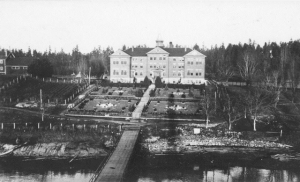Residential Schools and the Effects on Indigenous Health
Residential Schools: Background
Shingwauk Residential School, Sault Ste. Marie, Ontario
- Owned & operated by The Anglican Church of Canada
- Opened August 2nd, 1875
- New school opened October 3rd, 1935 & housed 140 pupils
- The school focused on teaching trades & agriculture
Jack was often subjected to:
- Harsh discipline
- Malnutrition
- Poor health
- Physical, emotional, and sexual abuse
- Deliberate suppression of his culture and language
Daily Schedule
| 5 AM | Bell rings; students rise, wash, & dress |
| 5:30 AM | Breakfast, then prayers |
| 6 – 9 AM | Boys work on farm; girls work in house |
| 9 – 12 PM | School |
| 12 – 1 PM | Lunch & recreation |
| 1 – 3:30 PM | School |
| 3:30 – 6 PM | Work on farm |
| 6 PM | Dinner & prayers |
| Evening | Boys: school in winter; work on farm in summer Girls: learn needlework |
| 9 PM | Bedtime |
Effects on Indigenous Health
Personal or familial residential school attendance is related to health in a multitude of ways. People who attended residential schools generally feel their health or quality of life has been negatively impacted.
General health: poorer overall self-rated health, less likely to seek health care
Physical health: chronic health conditions and infectious diseases
Mental health and emotional well-being: mental distress, depression, addictive behaviour, substance misuse, stress, and suicidal behaviours
Web of Being: Determinants and Indigenous People’s Health
Determinants of health can be conceptualized as either historical (distal) or contemporary (proximal). To understand the interconnectedness of these determinants and their combined influence on the general health of Indigenous peoples, one must look into the past.
Occupational Illness and Disease
Occupational health focused on the physical health – respiratory disease, the impact of noise, heat and vibration on the miners’ health. A significant number of miners are experiencing high levels of stress, anxiety, and depression (Centre for Research in Occupational Safety and Health).



